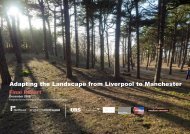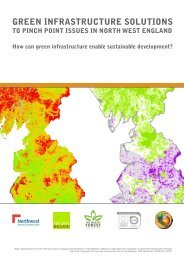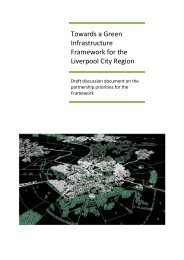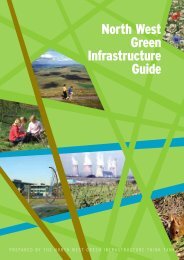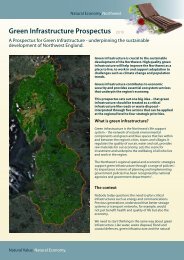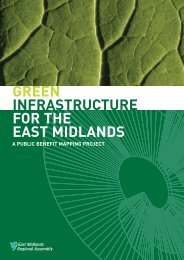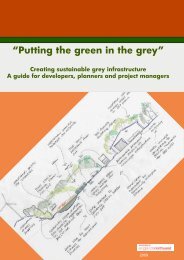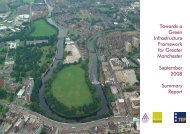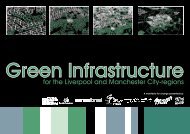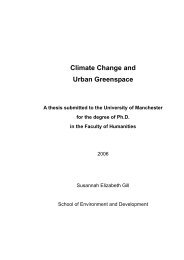The green infrastructure valuation toolkit user guide
The green infrastructure valuation toolkit user guide
The green infrastructure valuation toolkit user guide
Create successful ePaper yourself
Turn your PDF publications into a flip-book with our unique Google optimized e-Paper software.
Building natural value for sustainable economic development: <strong>The</strong> <strong>green</strong> <strong>infrastructure</strong> <strong>valuation</strong> <strong>toolkit</strong> <strong>user</strong> <strong>guide</strong><br />
Preparation<br />
Step 1: Initial analysis<br />
Scope and gather the information needed on the purpose, physical<br />
characteristics and beneficiaries of the project or site being assessed.<br />
Good information about the project or asset to be valued is essential. <strong>The</strong> better<br />
the information, the greater the accuracy of the <strong>valuation</strong>. A checklist of the<br />
initial data requirements is provided in Appendix 2.<br />
Core information such as the type, quantity and location of a <strong>green</strong> asset, its<br />
current and future use and so on, should be readily available from the project<br />
developers or asset owners.<br />
Step 2: Identifying beneficiaries<br />
Estimate the number of beneficiaries from the project or site being<br />
assessed. This will be needed for assessing recreation, tourism, health and<br />
property benefits.<br />
Many of the benefits of <strong>green</strong> <strong>infrastructure</strong> come from its use by humans – for<br />
recreation or tourism. Baseline figures for current use are therefore important to<br />
help assess the net additionality* of the <strong>green</strong> <strong>infrastructure</strong> investment – the<br />
net positive difference resulting from the investment.<br />
<strong>The</strong> affected population will be an estimate of the relevant ‘<strong>user</strong>’ and ‘non-<strong>user</strong>’<br />
population – the beneficiaries of the investment.<br />
<br />
<br />
‘Users’ benefit directly, by using the new or improved <strong>green</strong><br />
<strong>infrastructure</strong> - think of people using a park, or a new cycle path.<br />
‘Non-<strong>user</strong>s’ may also derive a benefit - for example, a city dweller may<br />
value investment to safeguard a rural habitat even if they have no<br />
intention to visit the site.<br />
In many cases, the most appropriate approach to identifying beneficiaries will be<br />
some form of population or household density or catchment analysis.<br />
Understanding this is important, as the value given to a <strong>green</strong> <strong>infrastructure</strong><br />
investment - and in particular non-marketed goods - is sensitive to distance.<br />
<strong>The</strong>re is a reduction in value further away from the <strong>green</strong> asset.<br />
Some methods commonly used to estimate the number of potential beneficiaries<br />
include:<br />
Method 1: Density of use. Where the proposed investment involves the provision<br />
of a cycleway or footway it is possible to estimate the likely level of use based on<br />
density values from other sites or areas.<br />
British Waterways’ economic impact model uses national data on<br />
density of use for walking and cycling per kilometre<br />
local authority leisure services departments may also have local leisure<br />
use data to draw upon.<br />
Method 2: Population penetration analysis. This approach estimates the likely use<br />
of the <strong>green</strong> asset by local residents or visitors, based on taking a percentage of<br />
the relevant population. It draws on household population data. <strong>The</strong> percentage<br />
penetration can be based on evidence from other areas or <strong>green</strong> <strong>infrastructure</strong>type<br />
projects or a bespoke leisure use study.<br />
Method 3: Catchment analysis. This method is useful to determine the relevant<br />
beneficiaries of <strong>green</strong> <strong>infrastructure</strong> investment - for example the number of<br />
residential or commercial properties within a certain visual range or travel-time<br />
distance.<br />
This type of analysis is also useful for estimating non-<strong>user</strong> benefits. Here the aim<br />
is to identify the relevant household population that may value the <strong>green</strong> asset for<br />
its option use* or existence. This may be based on a geographical area or drive<br />
time, depending on the findings from the evidence base.<br />
Method 4: Site transfer<br />
This estimates the likely total number of visits based on the experience of other<br />
similar sites. For example, a woodland of 50 hectares with 25,000 visits per year<br />
has a density of use of 500 people per hectare per year. This can be applied to<br />
your project, based on the scale of your site.<br />
Calculating catchments<br />
<strong>The</strong> Greater London Authority (GLA) publishes guidance on the preparation of<br />
open space strategies, which includes a series of catchment areas:<br />
regional parks, of up to 400 hectares in size and catchment area of 3.2<br />
to 8 kilometres<br />
<br />
<br />
district parks of up to 20 hectares and catchment area of 1.2 kilometres<br />
local parks of 2 hectares serving the local population within 400 metres.<br />
Other councils have drawn on the GLA’s guidance when working up their own<br />
strategies. For example, Kirklees 2007 open space assessment modified the<br />
15



